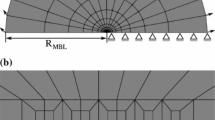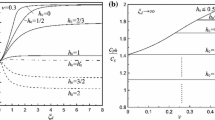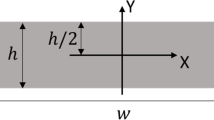Abstract
The problem of calculating the overall elastic moduli of a microcracked material is now understood relatively well, however, only under the assumption that the cracks are fixed, that is, neither grow nor shorten during loading. Such a calculation yields the secant moduli for the response stress-strain curves of microcracked materials. The present paper shows how this existing knowledge can be extended to calculate the tangential moduli for incremental deformations of the material during which the cracks are allowed to grow and remain critical, or shorten. For this purpose, the conditions that the energy release rate of several families of cracks in the material must on the average be in balance with the energy dissipation rate characterized by the fracture energy of the material are formulated. The results of preliminary numerical studies still in progress are reported. It is found that the self-consistent scheme for the calculation of elastic constants of a microcracked material does not give realistic results except for deformations up to shortly after the peak load. On the other hand, the differential scheme yields realistic stress-strain curves and it also gives a ratio of uniaxial tensile to compression strengths that is approximately correct for initially highly microcracked materials such as concrete. A comprehensive report on the computation of tangent moduli will be given in a separate paper.
Access this chapter
Tax calculation will be finalised at checkout
Purchases are for personal use only
Preview
Unable to display preview. Download preview PDF.
Similar content being viewed by others
References
Budiansky, B. and O’Connell, R.J., 1976. Elastic moduli of a cracked solid. Int. J. Solids and Structures, 12: 81–97.
Hoenig, A., 1978. The behavior of a flat elliptical crack in an anisotropic elastic body. Int. J. Solids and Structures, 14: 925–934.
Hoenig, A., 1979. Elastic moduli of a non-randomly cracked body. Int. J. Solids and Structures, 15: 137–154.
Kachanov, M., 1980. Continuum model of medium with cracks. J. Engng. Mech. Div. ASCE, 106 (EM5): 1039–1051.
Horii, H. and Nemat-Nasser, S., 1983. Overall moduli of solids with microcracks: load-induced anisotropy. J. Mech. Phys. Solids, 31 (2): 155–171.
Fabrikant, Y.I., 1987. Close interaction of coplanar circular cracks in an elastic medium. Acta Mechanica, 67: 39–59.
Ju, J.W. and Tseng, K.H., 1992. A three-dimensional statistical micromechanical theory for brittle solids with interacting microcracks. Int. J. Damage Mech., 1 (1): 102–131.
Kachanov, M., 1992. Effective elastic properties of cracked solids: critical review of some basic concepts. Applied Mechanics Review, 45 (8): 304–335.
Mauge, C. and Kachanov, M., 1992. Interacting arbitrarily oriented cracks in anisotropic matrix. Stress intensity factors and effective moduli. Int. J. Fracture, 58: R69–R74.
Fares, N., 1993. Effective stiffness of a periodically cracked 3-D solid. Int. J. Fracture, 62: 149–162.
Nemat-Nasser, S. and Yu, N., 1993. Solids with periodically distributed cracks. Int. J. Solids and Structures, 30 (15): 2071–2095.
Huang, Y., Hu, K.X., and Chandra, A., 1994. A self-consistent mechanics method for solids containing inclusions and a general distribution of cracks. Acta Mechanica, 105: 69–84.
Ju, J.W. and Chen, T.-M., 1994. Effective elastic moduli of two-dimensional brittle solids with interacting microcracks. Part I: Basic formulations. Part II: Evolutionary damage models. J. Appl. Mech. ASME, 61: 349–366.
Mauge, C. and Kachanov, M., 1994. Effective elastic properties of an anisotropic material with arbitrarily oriented interacting cracks. J. Mech. Phys. Solids, 42 (4): 561–584.
Sayers, C.M. and Kachanov, M., 1995. Microcrack-induced elastic wave anisotropy of brittle rocks. J. Geophysical Research, 100 (B3): 4149–4156.
Prat, P.C. and Bažant, Z.P., 1995. Elastic moduli of material with growing cracks. Technical Report (in preparation), Dept. of Civil Engng., Northwestern University, Evanston, IL 60208, USA.
Hill, R., 1965. A self-consistent mechanics of composite materials. J. Mech. Phys. Solids, 13: 213–222.
Hashin, Z., 1988. The differential scheme and its application to cracked materials. J. Mech. Phys. Solids, 36 (6): 719–734.
Kachanov, M., 1993. Elastic solids with many cracks and related problems. In Hutchinson, J. and Wu, T., editors, Advances in Applied Mechanics, Vol. 30, pp. 259–445. Academic Press.
Bažant, Z.P., 1994. Nonlocal damage theory based on micromechanics of crack interactions. J. Engng. Mech. ASCE, 120 (3): 593–617.
Bažant, Z.P. and Jirásek, M., 1994. Damage nonlocality due to microcrack interac-tions: statistical determination of crack influence function. In Bažant, Z.P., Bittnar, Z., Jirásek, M., and Mazars, J., editors, Fracture and damage in quasi-brittle structures, pp. 3–17. E & FN SPON.
Jirásek, M. and Bažant, Z.P., 1994. Localization analysis of nonlocal model based on crack interactions. J. Engng. Mech. ASCE, 120 (3): 1521–1542.
Sayers, C.M. and Kachanov, M., 1991. A simple technique for finding effective elastic constants of cracked solids for arbitrary crack orientation statistics. Int. J. Solids and Structures, 27 (6): 671–680.
Kachanov, M., Tsukrov, I., and Shafiro, B., 1994. Effective moduli of solids with cavities of various shapes. Applied Mechanics Review, 47 (1): S151–S174.
Vakulenko, A. A. and Kachanov, M., 1971. Continuum theory of medium with cracks. Mechanics of Solids, 6: 145–151.
Author information
Authors and Affiliations
Editor information
Editors and Affiliations
Rights and permissions
Copyright information
© 1995 Springer-Verlag Berlin Heidelberg
About this paper
Cite this paper
Bažant, Z.P., Prat, P.C. (1995). Elastic Material with Systems of Growing or Closing Cracks: Tangential Stiffness. In: Batra, R.C. (eds) Contemporary Research in Engineering Science. Springer, Berlin, Heidelberg. https://doi.org/10.1007/978-3-642-80001-6_4
Download citation
DOI: https://doi.org/10.1007/978-3-642-80001-6_4
Publisher Name: Springer, Berlin, Heidelberg
Print ISBN: 978-3-642-80003-0
Online ISBN: 978-3-642-80001-6
eBook Packages: Springer Book Archive




